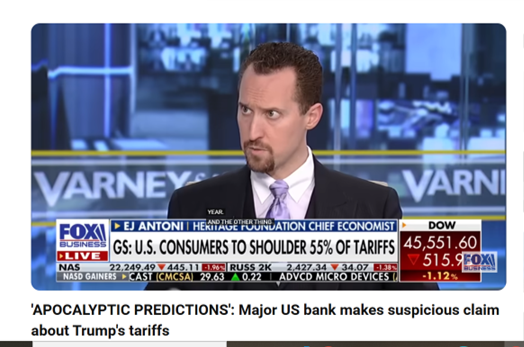See this clip, at 2:17. Over the longer term, the stock prices should equal the present discounted value of dividends, themselves relective of earnings and profits. That’s basic finance. That being said, there are over time substantial (apparent) deviations from the PDV of dividends (see Shiller, AER 1981), or big moves in the price-earnings ratio, defined in any way you want (12 month trailing, cyclically-adjusted, 1 year forward), as earnings fail to materialize, or the equity risk premium seemingly changes.
CPI Release: Instantaneous Core CPI, Nowcasted Core PCE Up Relative to 2024M12
Grocery inflation slightly above September ERS forecast for 2025 y/y, furniture prices continue to (technically speaking) zoom up.
Imagine No IEEPA Tariffs
Betting is now 37% Supreme Court upholding IEEPA tariffs.
Circumventing the Trump Administration’s Data Suppression: Billion $ Weather/Climate Disasters Efforts
As noted by CNN, the Trump administration’s deactivation of the website tracking climatic-related disasters has been partially alleviated by Climate Central‘s initiative.
What If? An Equity Market Correction Like 2001
In a recent Economist article, Gita Gopinath considered the implications of a AI bust similar in magnitude to the 2001 dotcom bust for the global economy.
The Fog of Uncertainty, Ag Edition
As American agriculture faces declining commodity prices amidst (tariff induced) rising input costs and heavy debt loads, here comes uncertainty, elevated by the Federal shutdown (from De Pillis, NYT):
Trade Expert EJ Antoni on Tariff Pass-Through
What Releases Have We Missed? What Will We Miss? And What Will Be the Impact?
Current betting on Kalshi is for a 34.5 day shutdown (5pm CT), taking us to November 3-4. At this rate, of the NBER BCDC key variables, we will miss consumption and personal income, and the August manufacturing and trade industry sales releases, as well as the Q3 advance GDP release. We’ve already missed the employment situation and industrial production releases.
EconoFact: “The U.S. Agricultural Sector Under Stress”
ARIMA(1,1,1) in BLS Private NFP vs. ADP Based ECM
I estimated three models, 2021-2025M08, resulting in adjusted R2 of between 0.54 (based on ADP data) to 0.71 (based on ADP data). Here’s what I got for forecasts of September and October private NFP as reported by BLS:
